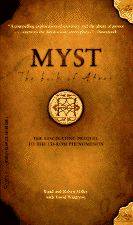

| Click on a book's image or title to order from Amazon.com |

The Book Of Atrus
by Rand and Robyn Miller with David WingroveHyperion, © 1995, PB, 399 pp, ISBN #0-7868-8188-7
Reviewed December 1997
This novel is the prequel to the excellent computer game MYST providing some of the backstory behind the events therein. Actually, it would be more accurate to say that this is the prologue to Riven, as the book's dramatic elements directly set up the storyline of the latter game than they explain the earlier.
Atrus is a young man who is of D'ni blood. The D'ni are a nearly-extinct race of men who lived in a great stone city deep within the Earth. They had perfected the art of writing books which would create whole new worlds, and use those books to transport ("link") themselves to those new worlds. Atrus is being raised by his grandmother, Anna, in a small crack of fertile land in the side of a volcano. She nurtures his sense of morality, reason and curiosity. Then, when Atrus is a teenager, his father, Gehn, comes to take him back to D'ni.
Gehn is an amoral man, set on restoring the D'ni people to their "rightful" place as gods of the worlds they create. As the last surviving D'ni, he and Atrus are to be the spearhead of the new race. The Book Of Atrus is Atrus' coming-of-age story, as he learns the skills of the D'ni, and sees his father for what he truly is.
The novel is not badly written, as one tends to expect "media tie-in" novels to be, although the plotting is rather weak and the writing style rather generic. The set-up and execution of the final confrontation between Atrus and Gehn is rather flimsily constructed, unfortunately. The book is at its most interesting when it gives us tantalizing glimpses of the dead D'ni world, and the subtleties of the art of book-writing, although it doesn't really explore either of these issues in satisfying depth.
The book also has some nicely-rendered illustrations by William Cone, although the composition of the illos is sometime muddy and it's hard to see exactly what they're depicting. They tend to be in a draftsman or blueprint style, rather than standard book illustrations.
It's not a bad book, and it reads quickly. But it certainly isn't half as interesting as the games.
hits since 13 August 2000.